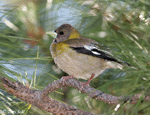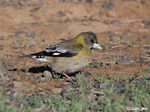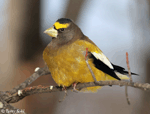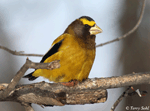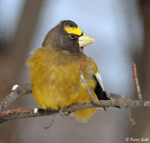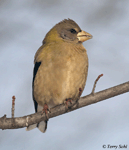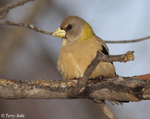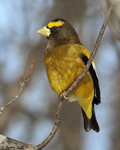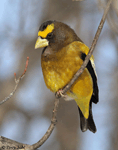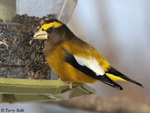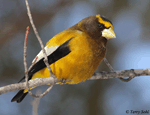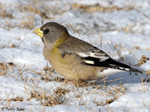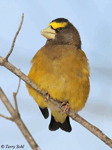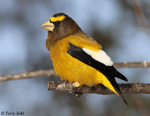Evening Grosbeak
Coccothraustes vespertinus
| Length: 8 inches | Wingspan: 13.5 inches | Seasonality: Primarily Winter |
| ID Keys: Males dark brownish yellow overall, with large white wing patch, yellow eyebrow and forehead, dark head and nape, black wings and tail. Large sturdy bill. | ||
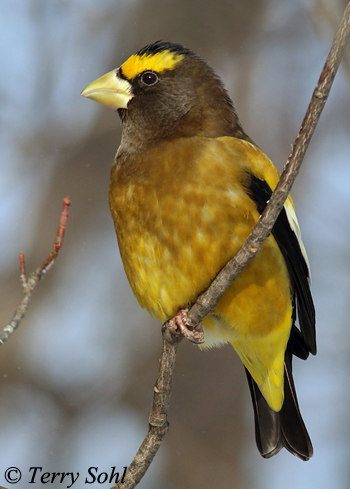 Evening Grosbeaks are primarily birds of northern and high
elevation forests of Canada and the western U.S. However, they
occasionally (and unpredictably) move well to the south and east of their normal
range during the winter months. Prior to 1900, they were only found in the
western half of North America. With the mass plantings of box elder and
other favorite trees and the prevalence of bird feeders, they now can be found
in the Great Lakes region and throughout the northeastern United States.
Evening Grosbeaks are primarily birds of northern and high
elevation forests of Canada and the western U.S. However, they
occasionally (and unpredictably) move well to the south and east of their normal
range during the winter months. Prior to 1900, they were only found in the
western half of North America. With the mass plantings of box elder and
other favorite trees and the prevalence of bird feeders, they now can be found
in the Great Lakes region and throughout the northeastern United States.
Habitat: Breeds in conifer and mixed forests. During migration and in winter, they can also be found in deciduous forests and semi-open country.
Diet: Feeds mostly on seeds, especially seeds of certain deciduous trees. They will also feed on fruits, berries, tree buds, and insects.
Behavior: Evening Grosbeaks are usually found foraging in flocks, except during the breeding season. They will forage at all levels of vegetation, from high in the tree stops to the ground.
Nesting: June and July
Song: A loud piercing peeer. Click to listen to the Evening Grosbeak song
Migration: Summers in much of Canada, and at higher elevations of the western United States. Some remain in these locations throughout the year, but others irregularly move well to the south during some winters.
Interactive eBird Map: Click here to access an interactive eBird map of Evening Grosbeak sightings
Similar Species: American Goldfinch
Bird Feeders: Will attend feeders for sunflower seeds and other items.
Conservation Status: Stable throughout most of its normal range. They have expanded their breeding range eastward over the last century.
Further Information: 1) USGS Patuxent Bird Identification InfoCenter, Evening Grosbeak
2) WhatBird - Evening Grosbeak
3) Audubon Guide - Evening Grosbeak
Photo Information: June 17th, 2008 - Near Trout Lake in Washington state - Terry Sohl
Additional Photos: Click on the image chips or text links below for additional, higher-resolution Evening Grosbeak photos.
| Click on the map below for a higher-resolution view |
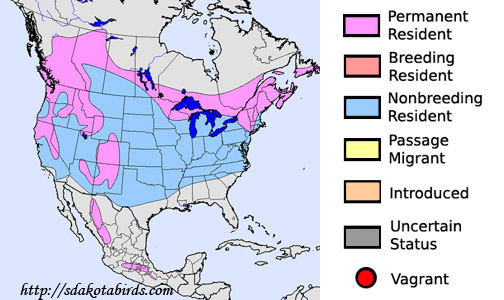 |
| South Dakota Status: Uncommon to rare at any season in the Black Hills, where they also nest. Very irregular winter visitor and migrant in the rest of the state. |
Additional Evening Grosbeak Photos
Click for a higher-resolution version of these photos
